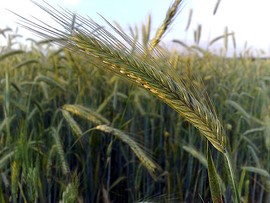Hybrid rye could be attractive to U.S. producers given the plant’s agronomic characteristics.
November 27, 2018

Rye has not traditionally been used as an ingredient in pig diets in the U.S., but researchers from the University of Illinois are now investigating the digestibility of nutrients in the grain.
Older rye hybrids had low yields, potential for toxic fungal contamination and limited market demand. The rye grown in the U.S. is typically consumed by people in breads and other baked products or used in the beverage industry, the university said, but following breeding advancements in Europe over the past 20 years, hybrid rye is producing far greater yields and is less susceptible to fungal contamination. Those varieties are now coming to the U.S. and Canada, according to the University of Illinois.
“Because hybrid rye has greater yields than all other small grains including conventional rye in Europe, it is likely that hybrid rye can also out-yield other small grains such as sorghum, wheat and barley on the drier soils in the U.S. and Canada. This may make hybrid rye an interesting ingredient in the feeding of pigs and other livestock species, but at this point, there is limited information about the nutritional value of hybrid rye when fed to pigs,” said Molly McGhee, a graduate student working with Hans Stein in the department of animal sciences at the University of Illinois.
McGhee and Stein have taken a first step toward understanding the nutritional value of hybrid rye with a study published in the Journal of Animal Science.
In the experiment, seven growing barrows were consecutively fed diets consisting of barley, wheat, corn and three types of hybrid rye: two grown in Europe and one in Canada. The grain, which was the sole source of amino acids and starch in each diet, was mixed with a small amount of soybean oil, vitamins and minerals to meet nutritional requirements. A nitrogen-free diet based on cornstarch and sucrose was also included in the experiment as a control.
McGhee collected samples of the ileal digesta from each diet and analyzed the digestibility of amino acids and starch. She also analyzed the overall nutrient composition and mycotoxin content of each grain source prior to feeding it to the pigs, the announcement said.
The apparent ileal digestibility (AID) of starch was greater in wheat and corn than in barley or hybrid rye, but starch AID values in all diets were greater than 95%, the researchers reported. Most amino acids were found in higher concentrations in hybrid rye than in corn, but they were less digestible in rye than in the other grains. The three rye hybrids did not differ substantially from each other in terms of nutrient composition or digestibility.
“We think the amount of digestible amino acids was less in hybrid rye than in barley and wheat because they are higher in protein overall. Essentially, hybrid rye comes out in the middle of those other cereal grains for digestibility of both amino acids and starch,” Stein said. “Hybrid rye has the potential to be cost effective in comparison with other cereal grains when used in diets for pigs.”
Although the work is just beginning — Stein and McGhee have several more experiments planned — the use of hybrid rye in pig diets could be attractive to U.S. farmers and the feed industry given the plant’s agronomic characteristics, the university said, noting that rye is drought tolerant, overwinters well in most locations, produces high yields and is less expensive to grow than corn.
“This is the first experiment we have conducted, but we will have a lot more data in the future. We think that when we have finished our research over the next couple of years, we’ll have a good handle on the nutritional value of hybrid rye. Then the feed industry can use it to formulate diets,” Stein said.
The study was supported by KWS Lochow GmbH of Germany.
You May Also Like


.png?width=300&auto=webp&quality=80&disable=upscale)
